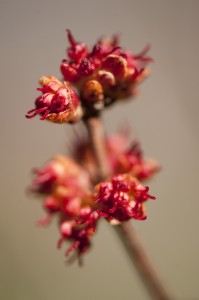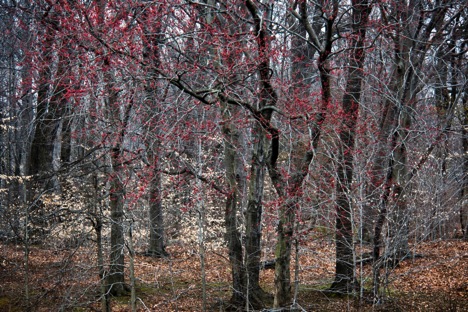An Unsung Harbinger of Spring
Posted in Horticulture on March 28 2014, by Todd Forrest
Todd Forrest is the NYBG’s Arthur Ross Vice President for Horticulture and Living Collections. He leads all horticulture programs and activities across the Garden’s 250-acre National Historic Landmark landscape, including 50 gardens and plant collections outside and under glass, the old-growth Thain Family Forest, and living exhibitions in the Enid A. Haupt Conservatory.
 For most people who anxiously await the end of winter, spring begins when the first brassy bulbs emerge from just-thawed soil. Not for me. While I am as enthusiastic about the appearance of snowdrops, crocuses, reticulate irises, and glories-of-the-snow as your average winter-weary garden watcher, what really warms my heart are early spring flowers that don’t make the evening news—those of our native red maples (Acer rubrum).
For most people who anxiously await the end of winter, spring begins when the first brassy bulbs emerge from just-thawed soil. Not for me. While I am as enthusiastic about the appearance of snowdrops, crocuses, reticulate irises, and glories-of-the-snow as your average winter-weary garden watcher, what really warms my heart are early spring flowers that don’t make the evening news—those of our native red maples (Acer rubrum).
As March transmogrifies from lion into lamb, I look skyward hoping to catch a glimpse of the flowers of red maple as they peek out of disintegrating winter buds. At a distance, a red maple tree in full bloom is a tangle of gray limbs enveloped in a carmine haze. The individual flowers are quite small, but a mature tree can produce hundreds of thousands of five-flowered clusters, which together create the most ethereal of all spring spectacles.
Evolved to thrive in our mercurial climate, red maples provide no false promise of spring. They remain dormant during the mid-winter warm spells that can trick star magnolias into premature bloom, thus avoiding the ignoble brown-mush phase that so often afflicts these precocious imports from gentler climes. When spring is reluctant to arrive, red maple flowers are painfully slow to emerge from their buds as if to tell us that we should wait another week or two to pack away our snow shovels.

So, when the red maples sprinkled through the remnant woodlands that line the parkways of my commute can be recognized at 60 miles per hour, I know that winter has lost its teeth. Sure, there may be a magnolia-withering cold snap on the horizon, but the red maples assure me that I may officially begin to celebrate the wild and wonderful explosion of life that marks spring in New York.

